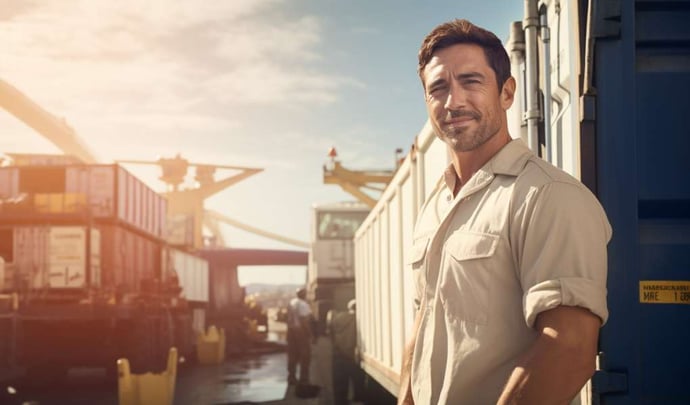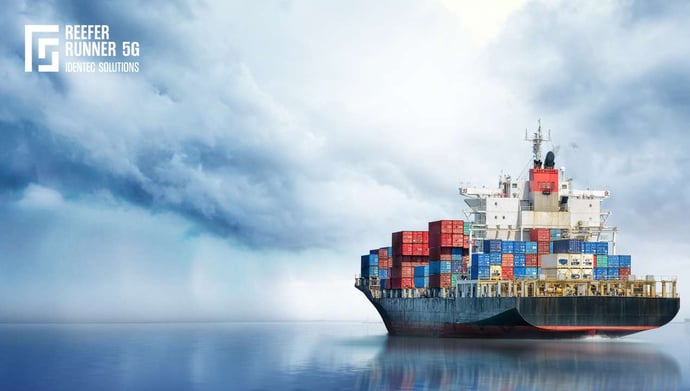Cold Chain Solutions: Assure cargo integrity with 5G
| Written by Mark Buzinkay
What does a supply chain entail?
A supply chain encompasses all the phases in the creation and distribution of a particular product. The chain traces the product from its origin as a raw material to its ultimate placement in a store or storage facility. International supply chains have become a norm in numerous sectors over the preceding 30 years. In such systems, the conceptualization, promotion, and sales activities predominantly occur in the affluent economies of Europe, North America, and Asia, whereas the actual production largely takes place in 'developing' nations across Asia, Africa, and the Americas. The links in the supply 'chain' are the consecutive steps starting from the cultivation or extraction of raw materials (like cotton, metal, oil, etc.) and culminating in the sale of the end products to consumers by the dominant company in the supply chain, often termed the 'lead' company. Regional value chains are also seeing increased significance, especially in places like South America and Africa, with countries like Chile or Brazil exporting agricultural goods to their neighbours.
A conventional global supply chain is intricate and multi-tiered and engages a diverse array of organizations, suppliers, and stakeholders.
For instance, clothing supply chains are frequently perceived as straightforward, but they are more complex in reality. In sectors like clothing, the primary companies – occasionally labelled as 'brands' – don't possess any manufacturing plants. These lead companies 'outsource' the entire production to standalone factories. They might switch suppliers from one factory to another every season, seeking more competitive rates or unique expertise. If lace attire is trendy one season and denim the subsequent one, brands might source from a lace-producing factory one season and a denim one the next.
How Significant is the Cold Chain within the Supply Chain?
Even though globalization has diminished the relative distance between global regions, the actual geographical separation remains crucial. The larger the geographical gap, the higher the chance of cargo getting harmed during one of the intricate transportation stages. Some items might be affected by jolts, while others might be harmed by excessive temperature fluctuations. For a category of goods termed perishables, especially food items, their quality deteriorates over time due to ongoing chemical reactions, the pace of which can be largely reduced with cooler temperatures. Efficiently moving a consignment takes time and coordination, and any holdups can lead to adverse outcomes, especially if the cargo is perishable. To guarantee that cargo remains intact throughout this journey, sectors like pharmaceuticals, healthcare, and food are increasingly leaning on the cold chain.
The cold chain pertains to the conveyance of temperature-sensitive items along a supply chain using thermal and cooled packaging techniques and logistical strategies to safeguard these consignments' integrity. Various methods exist for transporting cold chain goods, including cooled trucks and trains, refrigerated ships, reefers, and air freight.
Some local or cross-border supply chains might rely on a single mode of transport, but often, land shipments are just one part of a mix of transportation methods. This makes the transition between modes pivotal for the cold chain. Intermodal consignments usually employ 40-foot cooled containers capable of accommodating up to 26 tons of food. These containers streamline the loading and unloading durations, reducing potential harm to both the container and its contents. The conditions inside these containers are electronically regulated, either by connecting to a generator or power source on the vessel, truck, or terminals and distribution hubs. The proficiency of cold chain logistics has enabled the merging of cold storage facilities to cater to expansive market zones.
Transporting a consignment through the supply chain without any hitches or temperature deviations demands a thorough logistical procedure to uphold the consignment's integrity. This procedure encompasses various stages, from the consignment's preparation to the final inspection of its integrity at the delivery endpoint - including consignment preparation, mode selection, customs protocols, the last leg, and quality checks.
Once the consignment is delivered, any temperature recording instruments or detected temperature deviations must be documented and disclosed. This phase of the logistical procedure fosters trust and responsibility, especially if there's accountability for a compromised consignment. If issues or deviations that jeopardize a consignment arise, efforts should be made to pinpoint the cause and implement corrective measures. This is especially pertinent given the high worth of cold chain items. While a regular container load might be valued between $50,000 and $100,000, a refrigerated load's value can soar to $1 million. In the pharmaceutical domain, the cargo's value can skyrocket to $50 million. (1)
The cold chain tracking challenge and solution
Until today, reefer monitoring was either done manually or with the help of automated systems at container terminals. Some containers have built-in modems yet only deliver a small subset of monitoring data once per 24 hours. But for a forwarding company, owners of river barges, and managers of a train company, these technical solutions are just not good enough.
What is needed is complete reefer monitoring everywhere and at any time. Successful reefer management is all about visibility and real-time alarms to avoid mishaps that cost money and reduce efficiency, but most importantly, they assure integrity and quality of the cargo.
A successful solution to this challenge needs remote and mobile monitoring of temperature and other reefer data, including the location of the refrigerated container, super-easy deployment of the monitoring and tracking device, free of any other installations, and no manual interaction to access the data.
Independently of a reefer type, Reefer Runner 5G will upgrade them instantly to being "smart". It gives the operations manager full remote visibility of reefers out of the box. The reefer data becomes accessible everywhere through a web browser, including the current position of the reefer. Eventually, you need only one system for all reefer tasks in the cold chain. If the reefer is outside of any 5G connection, Reefer Runner 5G is caching offline data for later to synchronize it with the central cloud-based database.
One of the main advantages of reefer monitoring solutions like Reefer Runner 5G is that no installation is required at all. They simply connect to the data port, and they collect and transmit data. The low installation effort makes Reefer Runner 5G as easy to implement as it is powerful - out-of-the-box deployment means plugging it into the data port, and all necessary monitoring data becomes visible.
Cold chain tracking with solutions like Reefer Runner 5G not only give you all the reefer data that is needed to ensure a safe voyage, but they also give you a real-time overview of where all reefers are located, implicating that ETA can be adapted and customers can be informed much more precisely and in advance. It's important for the receiver of the shipment to have everything ready to park, plug and clear the refrigerated containers at their own premises.
FAQs
What is cold chain tracking?
Cold chain tracking refers to the monitoring and recording of temperature-sensitive products as they move through the supply chain. This ensures that the products, often perishables like food and pharmaceuticals, are stored and transported within specified temperature ranges to maintain their quality and safety. Tracking systems typically use sensors and data loggers to continuously monitor temperature and other environmental conditions, sending alerts if there are deviations from the set parameters.
Why is cold chain tracking important?
Cold chain tracking is crucial for several reasons:
- Safety and Quality Assurance: Many products, especially pharmaceuticals and certain food items, can become unsafe or lose their efficacy if exposed to temperatures outside their recommended range.
- Regulatory Compliance: Many regions have strict regulations regarding the transportation and storage of temperature-sensitive products. Cold chain tracking helps companies prove compliance with these regulations.
- Waste Reduction: By ensuring products are kept at optimal conditions, cold chain tracking reduces the risk of spoilage and waste, leading to cost savings and environmental benefits.
How does cold chain tracking technology work?
Cold chain tracking technology typically involves a combination of the following components:
- Temperature Sensors/Data Loggers: These devices continuously measure the temperature within a storage or transport unit. They can store data for later retrieval or transmit it in real-time.
- Connectivity Solutions: These can range from simple RFID tags to advanced IoT (Internet of Things) devices that send data to a centralized system using cellular, satellite, or other wireless communication methods.
- Centralized Monitoring System: This system collects data from all sensors and provides real-time visibility into the conditions of shipments. It can generate alerts for any deviations from set parameters and produce reports for analysis and compliance purposes.
By integrating these components, cold chain tracking technology provides a comprehensive view of the product's environment throughout its journey, ensuring it remains within safe and optimal conditions.
Takeaway
Cold chain tracking is an essential aspect of modern supply chain management, especially for temperature-sensitive products like pharmaceuticals and certain food items. It ensures that these products are consistently stored and transported within their specified temperature ranges, guaranteeing their quality, safety, and efficacy. The technology behind cold chain tracking typically combines temperature sensors or data loggers, advanced connectivity solutions, and a centralized monitoring system. This integration offers real-time visibility into the conditions of shipments, generating alerts for any deviations and producing reports for both analysis and regulatory compliance. As global trade continues to expand and regulations become even more stringent, the importance of cold chain tracking will only grow. It not only ensures product safety and compliance but also significantly reduces the risk of spoilage and waste, leading to both economic and environmental benefits. Reefer Runner 5G is an interesting option for reefer monitoring and tracking in the intermodal cold chain.
Delve deeper into one of our core topics: Cold Chain Monitoring
Glossary
Out-of-the-box deployment refers to the quick implementation of a pre-configured software or hardware solution that requires minimal customization. These solutions are designed for immediate usability, offering standardized features that address common business needs. It streamlines deployment by reducing setup complexity, time, and costs. While convenient, it may lack flexibility for highly specific requirements, making it ideal for straightforward use cases. (2)
Sources:
(1) Yee Jher Chan, Nareen Anwar, Nigel Forest Reuel: Cold and ultra-cold chain integrity monitoring via embedded resonant sensor indicators, Sensors and Actuators A: Physical, Volume 372, 2024, 115346, ISSN 0924-4247, https://doi.org/10.1016/j.sna.2024.115346.
(2) Loshin, David. Enterprise Knowledge Management: The Data Quality Approach. 2001. Morgan Kaufmann, San Francisco.
Note: This article was updated on the 28th of January 2025

Author
Mark Buzinkay, Head of Marketing
Mark Buzinkay holds a PhD in Virtual Anthropology, a Master in Business Administration (Telecommunications Mgmt), a Master of Science in Information Management and a Master of Arts in History, Sociology and Philosophy. Mark spent most of his professional career developing and creating business ideas - from a marketing, organisational and process point of view. He is fascinated by the digital transformation of industries, especially manufacturing and logistics. Mark writes mainly about Industry 4.0, maritime logistics, process and change management, innovations onshore and offshore, and the digital transformation in general.
Related Articles
Related Product





